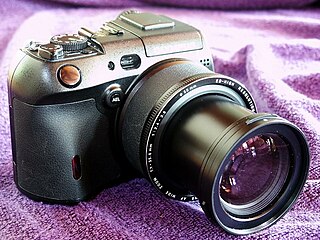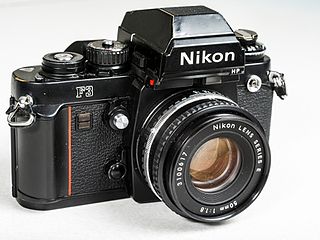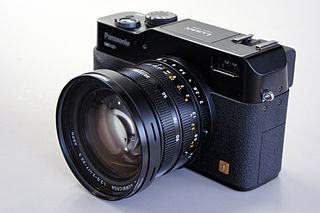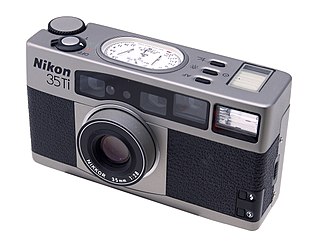
A single-lens reflex camera (SLR) is a camera that typically uses a mirror and prism system that permits the photographer to view through the lens and see exactly what will be captured. With twin lens reflex and rangefinder cameras, the viewed image could be significantly different from the final image. When the shutter button is pressed on most SLRs, the mirror flips out of the light path, allowing light to pass through to the light receptor and the image to be captured.

Leica Camera AG is a German company that manufactures cameras, optical lenses, photographic lenses, binoculars, rifle scopes and microscopes. The company was founded by Ernst Leitz in 1869, in Wetzlar, Germany.

The Olympus C-8080 WZ is a digital camera formerly manufactured by Olympus. It was first announced on the opening day of the 2004 Photo Marketing Association Annual Convention and Trade Show. At the time, the C-8080 was set to be Olympus’ first eight-megapixel digital camera for the high-end consumer market. The MSRP was $1,149 USD.

Minolta Co., Ltd. was a Japanese manufacturer of cameras, camera accessories, photocopiers, fax machines, and laser printers. Minolta Co., Ltd., which is also known simply as Minolta, was founded in Osaka, Japan, in 1928 as Nichi-Doku Shashinki Shōten. It made the first integrated autofocus 35 mm SLR camera system. In 1931, the company adopted its final name, an acronym for "Mechanism, Instruments, Optics, and Lenses by Tashima".

A point-and-shoot camera, also known as a compact camera and sometimes abbreviated to P&S, is a still camera designed primarily for simple operation. Most use focus free lenses or autofocus for focusing, automatic systems for setting the exposure options, and have flash units built in. They are popular for vernacular photography by people who do not consider themselves photographers but want easy-to-use cameras for snapshots of vacations, parties, reunions and other events.

TC-1 is a luxury point and shoot camera that was produced by Minolta. It is a compact 35 mm clad in titanium, equipped with a G-Rokkor 28mm f/3.5 lens. The TC-1 was equipped with a high quality lens and body, similar to other luxury compacts produced during the Japanese bubble economy era, including the Contax T line, Konica Hexar, Leica minilux, Nikon 28/35Ti, Ricoh GR series, and Rollei QZ 35W/35T. Expensive when initially released in 1996 with a suggested retail price of ¥148,000, it was produced in small numbers and since then has become collectible.

The Canon PowerShot G is a series of digital cameras introduced by Canon in its PowerShot line in 2000. The G series cameras are Canon's flagship compact models aimed at photography enthusiasts desiring more flexibility than a point-and-shoot without the bulk of a digital single-lens reflex camera.

The Nikon F3 was Nikon's third professional single-lens reflex camera body, preceded by the F and F2. Introduced in 1980, it had manual and semi-automatic exposure control whereby the camera would select the correct shutter speed. The Nikon F3 series cameras had the most model variations of any Nikon F camera. It was also the first of numerous Nikon F-series cameras to be styled by Italian designer Giorgetto Giugiaro, and to include a red stripe on the handgrip – a feature that would later become a signature feature of many Nikon cameras.
The Olympus OM System was a line of 35mm single-lens reflex cameras, lenses and accessories sold by Olympus between 1972 and 2002. The system was introduced by Olympus in 1972. The range was designed by Yoshihisa Maitani, chief designer for Olympus, and his staff; OM stands for Olympus Maitani.

The history of the single-lens reflex camera (SLR) begins with the use of a reflex mirror in a camera obscura described in 1676, but it took a long time for the design to succeed for photographic cameras. The first patent was granted in 1861, and the first cameras were produced in 1884, but while elegantly simple in concept, they were very complex in practice. One by one these complexities were overcome as optical and mechanical technology advanced, and in the 1960s the SLR camera became the preferred design for many high-end camera formats.

Lumix is Panasonic's brand of digital cameras, ranging from pocket point-and-shoot models to digital SLRs.

Bridge cameras are cameras that fill the niche between relatively simple point-and-shoot cameras and interchangeable-lens cameras such as mirrorless cameras and single-lens reflex cameras (SLRs). They are often comparable in size and weight to the smallest digital SLRs (DSLR), but lack interchangeable lenses, and almost all digital bridge cameras lack an optical viewfinder system. The phrase "bridge camera" has been in use at least since the 1980s, and continues to be used with digital cameras. The term was originally used to refer to film cameras which "bridged the gap" between point-and-shoot cameras and SLRs.

The Pentax ME F was an amateur level, interchangeable lens, 35 mm film, single-lens reflex (SLR) camera. It was manufactured by Asahi Optical Co., Ltd. of Japan from November 1981 to 1984. The ME F was a heavily modified version of the Pentax ME-Super, and a member of the Pentax M-series family of SLRs. It was the first mass-produced SLR camera to come with an autofocus system.

The Konica Hexar RF is a 35 mm rangefinder camera which was sold by Konica. It was introduced to the market on 13 October 1999. and subsequently discontinued some time before the end of 2003. The camera used the "Bayonet Konica KM-mount", a copy of the Leica M-mount, thus sharing interchangeable lenses with those designed for Leica cameras and others compatible with them. The Hexar RF has a combined rangefinder/viewfinder modeled on that of Leica cameras, a similar body shape and size - and so is similar to Leica M-mount cameras in many aspects of operation.

The Konica Hexar is a 35 mm fixed-lens, fixed focal length autofocus camera which was produced through the 1990s. It was introduced to the market in 1993. While styled like a rangefinder camera, and intended for a similar style of photography, in specification it is more like a larger "point and shoot" camera.

The Bessa family of cameras was manufactured in Japan by Cosina as a revival of the Voigtländer brand name.
This article discusses the cameras – mainly 35 mm SLRs – manufactured by Pentax Ricoh Imaging Corp. and its predecessors, Pentax Corporation and Asahi Optical Co., Ltd.. Pentax must not be confused with Pentax 6x7 or Pentax 67 which are 120 medium format 6x7cm film cameras.

The Panasonic Lumix DMC-LX7, or LX7, is a high-end compact "point and shoot" camera launched by Panasonic in 2012 to succeed the LX5.
The Contax T camera line consists of a number of compact cameras sold by Kyocera under the Contax brand. They were introduced between 1984 and 2002. The T, T2, and T3 use 35mm film and have a fixed 35 mm wide-angle lens. The T-VS, T-VS II, and T-VS III also use 35 mm film but have a 28–56 mm lens. The Tix uses APS film and has a fixed 28 mm wide-angle lens. The TVS Digital is a 5 MP digital camera with a 35–105 mm (equivalent) lens.

The Nikon 35Ti (1993) and Nikon 28Ti (1994) are luxury titanium-clad point and shoot cameras that were produced by Nikon, equipped with a high-quality lens and body, competing with similar luxury compact cameras produced during the Japanese bubble-economy era, including the Contax T line, Konica Hexar, Leica minilux, Minolta TC-1, Ricoh GR series, and Rollei QZ 35W/35T. Both the 35Ti and 28Ti are 35 mm cameras with nearly identical operation; as the name implies, the 35Ti is equipped with a 35 mm focal length lens, while the 28Ti is equipped with a 28 mm lens. Externally, they may be distinguished by their color: the 35Ti is finished in chrome/silver, and the 28Ti is finished in black.




















